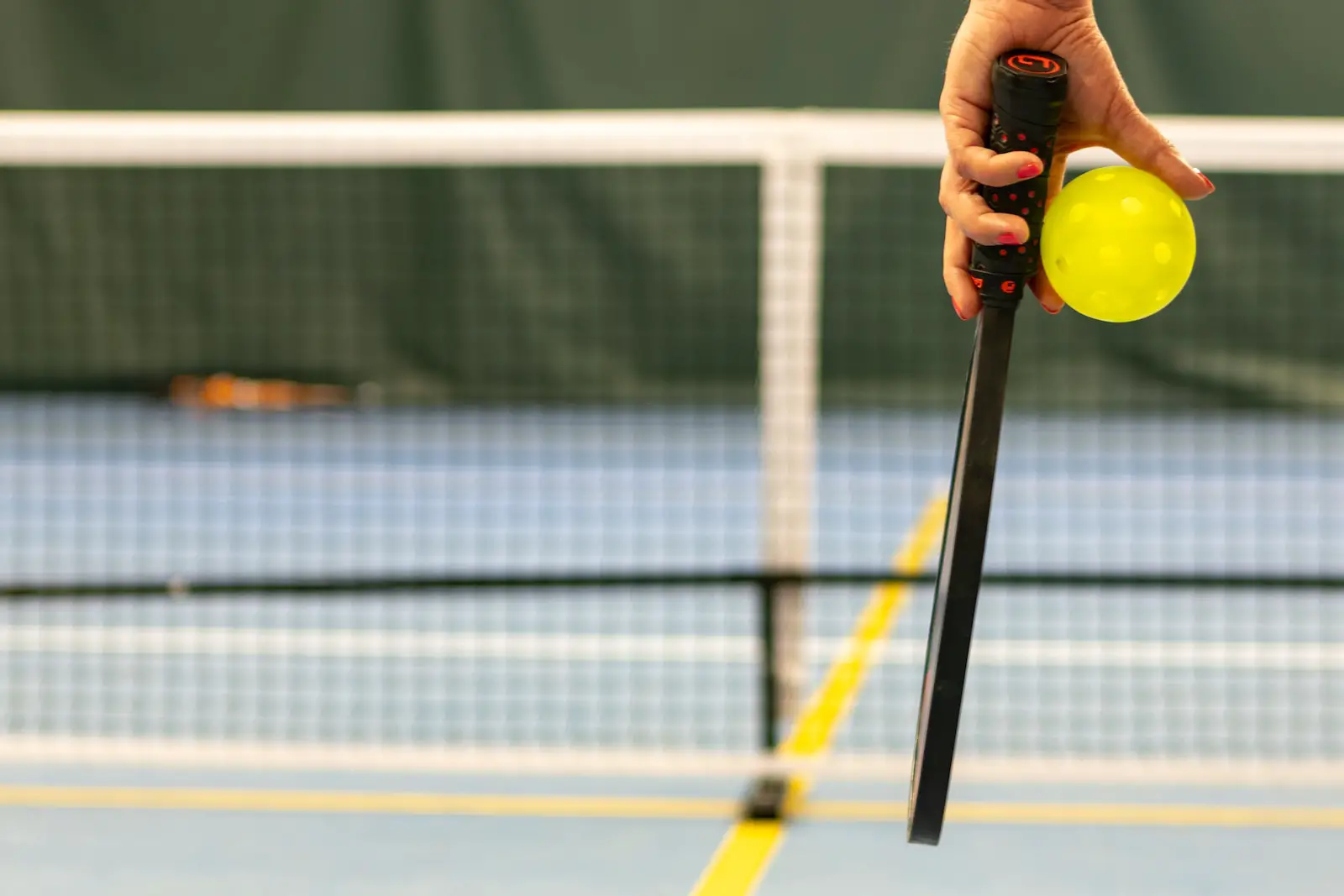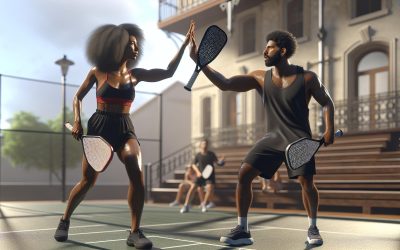In the dynamic world of pickleball, understanding the non-volley zone can be a game-changer. It’s this unique area on the court that sets pickleball apart from other racket sports. Also known as the “kitchen,” mastering this zone is key to improving your game strategy.
The non-volley zone rules might seem complicated at first, but don’t worry. I’m here to break it down and make it simple for you. Whether you’re a beginner or an experienced player looking to brush up on your skills, you’re in the right place. Let’s dive into the world of non-volley zone pickleball.
Remember, pickleball isn’t just about power and speed. It’s also about strategy and finesse. And understanding the non-volley zone is a critical part of that equation. So, get ready to enhance your pickleball game like never before.
What is the Non-Volley Zone?
As we delve into this meticulously strategized game of pickleball, the concept of the Non-Volley Zone, or as it’s fondly known, the ‘kitchen’, becomes essential. I’m here to break it down for you in the simplest of terms.
In essence, the ‘kitchen’ is a 7-foot zone on both sides of the net. A player cannot enter this distinctive area to volley the ball (hit it before it bounces). There are a few exceptions – for instance, you’re allowed to step into the kitchen if the ball has already bounced within it. However, once you’re in there, you can’t volley the ball even if you’ve managed to step back out.
There are 2 primary purposes of the Non-Volley Zone. First, it stifles the smash – an aggressive overhead shot, often resulting in an uncontested point in many other racket sports. The kitchen rules ensure that no player can dominate simply by overpowering their opponents from close range.
Secondly, the Non-Volley Zone enhances strategy and finesse play in pickleball. Picture a chessboard rather than a boxing ring. Pickleball isn’t about who hits the hardest, but about who thinks the fastest.
| NON-VOLLEY ZONE DIMENSIONS |
|---|
| 7′ x 20′ |
Remember, understanding the Non-Volley Zone is integral to your rise as a pickleball player. Now don’t get daunted by its complexity. With practice and a little patience, you’ll soon develop a natural feel for it and incorporate it to outsmart your opponents.
Why is the Non-Volley Zone Important in Pickleball?
The importance of the Non-Volley Zone, or “kitchen,” as it’s affectionately called by pickleball enthusiasts, can’t be overstated. Understanding and utilizing the kitchen effectively is fundamental to successful play and elevating your game. It’s a crucial area of the court that can impact the gameplay and outcomes in significant ways.
The two main roles of the kitchen are:
- Preventing players from executing aggressive overhead shots at close range.
- Increasing the strategic and finesse aspects of the game.
The first role of the kitchen is to maintain a level playing field among players. A player can’t dominate the game by staying too close to the net and making powerful volleys. By restricting players from making such volleys within a 7-foot stretch on both sides of the net, the kitchen ensures an even balance of power and skill.
Requiring players to back off from the net opens up the court for a wider variety of shots, such as drop shots, lobs, and dinks. It compels players to develop a more rounded skill set, rather than just relying on brute power.
As for the second role, the kitchen fosters strategic gameplay. It’s not just about preventing players from being overly aggressive, but also about fostering strategic and skillful play. The kitchen forces players to think about their shot placement and court positioning, encouraging a higher level of strategy and control. Players have to be quick on their feet, think several moves ahead, and continually adapt to the flow of the game.
To be effective in pickleball, you need to be familiar with the non-volley zone rules and know how to play within and around this area. How well you understand and implement these rules could mean the difference between a winning and a losing point. The non-volley zone isn’t just a regulatory feature of the court; it’s a dynamic, strategic element that’s integral to the game of pickleball.
Understanding the Non-Volley Zone Rules
The non-volley zone rules in pickleball are pretty simple once you dig into them. They’re designed to ensure fairness during gameplay and to prevent any team or player from gaining an unfair advantage.
First and foremost, when you’re in the kitchen, you’re not allowed to execute a volley shot. A volley in terms of pickleball refers to striking the ball while it’s in the air, without letting it bounce first. Hold up, you might be thinking. Can’t I just step into the kitchen for a moment, pull off my volley, then step back out again? Unfortunately, no. The rule is straightforward – if you are in the kitchen, you cannot strike a volley.
I want to add, this rule applies even if you’re in the air and over the kitchen line when you make contact with the ball. So it’s not just your feet your need to watch out for.
Also, the rule counts not just for the time of striking the ball, but also till your momentum carries you forward after executing a volley. It is illegal to volley the ball while one’s momentum takes them into the non-volley zone including on serve return.
What about a temporary foray into the kitchen after a volley? Nope, still not allowed. I’ve seen many a pickleball player get tripped up on this point. Even if you hit your volley while outside the kitchen, and then your momentum carries you into the kitchen, your shot is considered a fault.
The game’s not all about strict rules and where you can’t go though. The kitchen also provides a great opportunity for strategy. Your opponents can’t hit a volley while in the kitchen, so you’ve got a great opportunity to force them into tough positions by landing your shot in the kitchen.
Developing a solid understanding, and then living out these non-volley zone rules will totally elevate your game. Without the ability to simply overpower their opponents with smash shots, players have no choice but to learn finesse and strategy. We’ll delve more deeply into finesse and strategy in our upcoming section, helping you maximize your gameplay.
Tips and Strategies for Playing in the Non-Volley Zone
When you’re dealing with the non-volley zone (or the kitchen), I’ve found several tips and strategies that can dramatically improve your gameplay. While playing pickleball, your skills will be tested, and the real drama unfolds in the 7-foot stretch on both sides of the net, known as the kitchen. You can’t just rely on power; you need strategy and finesse as well. With that in mind, let’s dive into some tips to help you get the most out of the kitchen.
Patience is key. In the high pressure kitchen, staying patient is crucial. You don’t want to rush into a volley or miss an opportunity for a great return shot. Wait for the perfect moment to make your move. It’s better to engage in a long rally than make a rash decision that hands the advantage over to your opponent.
Keep your feet outside the kitchen line when volleying. As I’ve already mentioned, the rules of the non-volley zone include the prohibition of executing volleys while in the kitchen. Always be mindful of your footwork. Meanwhile, it’s also a no-go zone for momentum-carrying moves after a volley. Bearing this in mind will help you avoid losing points due to technical faults.
Work on your dink shots. Dink shots are soft, controlled shots designed to land within the kitchen. They are fantastic for countering an aggressive opponent and shifting the balance of play. By mastering these shots, you will add another string to your bow, making it difficult for opponents to predict your next move.
Improve your shot placement. Making the most of the non-volley zone isn’t just about avoiding faults; it’s about using the space of the kitchen to outmaneuver your adversary. This takes practice, careful observation, and an understanding of your opponents’ tendencies.
There you have it! These strategies can give you an edge when you’re up against tough opponents. They’re not the silver bullet to pickleball dominance, but they’re reliable techniques to have in your repertoire. As always, it’s not just about understanding the rules or mastering techniques; it’s about continuous practice and consistent play that even the non-volley zone, the kitchen, becomes a playground to showcase your skills.
Common Mistakes to Avoid in the Non-Volley Zone
Navigating the non-volley zone, or “kitchen,” can be a challenging part of pickleball for both new and experienced players. It’s vital to be aware of common mistakes that can adversely affect your game and strategy.
Hitting Too High: One common mistake you’ll see players making involves hitting the ball too high over the net. This tends to leave the shot vulnerable to a powerful volley from the opposing player. It’s key to focus on keeping your shots low, not giving the opponent an easy opportunity to strike.
Foot Faults: Foot faults are a major faux pas in the non-volley zone. Recall, you’re not allowed to hit a volley – a ball in the air – while your foot is in the kitchen. Constant awareness of where your feet are relative to the lines of the non-volley zone is crucial to avoid these infringements.
Rushing the Game: Let’s not forget about the importance of patience in pickleball. Players often rush to finish points quickly, leading to poor shot selection and placement. Patience and measured play allow for better control of the ball, leading to a strategically superior game.
Improper Use of Dink Shots: Dink shots, if executed correctly, can be a powerful tool in the kitchen. However, many players fail to use them to their full potential. A common mistake is hitting the dink shot too hard, causing it to go too high and availing the opponent an opportunity to attack.
Neglecting Line Shots: Line shots are another strategic maneuver that’s often neglected. These shots are placed just inside the lines of the court, forcing your opponent to move side-to-side, consequently tiring them out.
Conclusion
Mastering the non-volley zone or ‘kitchen’ in pickleball is key to leveling up your game. It’s not just about power but about finesse and strategy. Patience and precision can give you an edge, with dink shots and shot placement playing crucial roles. Remember, it’s important to keep your feet outside the kitchen line when volleying. Avoid common mistakes like hitting too high or rushing the game. Understand that the kitchen isn’t just a restriction, it’s an opportunity to showcase your skills and outwit your opponent. With practice and a keen understanding of the kitchen’s role, you’ll be well on your way to becoming a formidable pickleball player. Embrace the kitchen and let it serve you well in your pickleball journey.














0 Comments